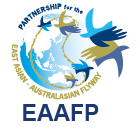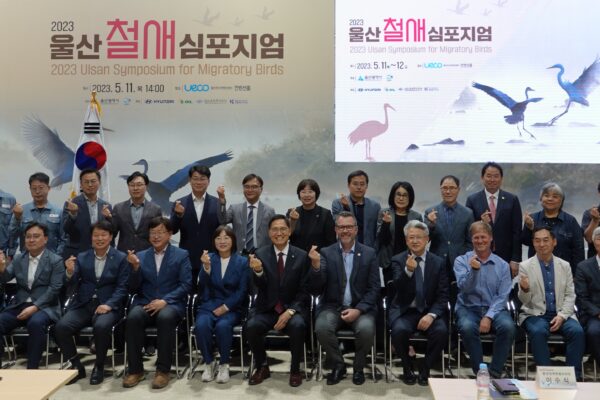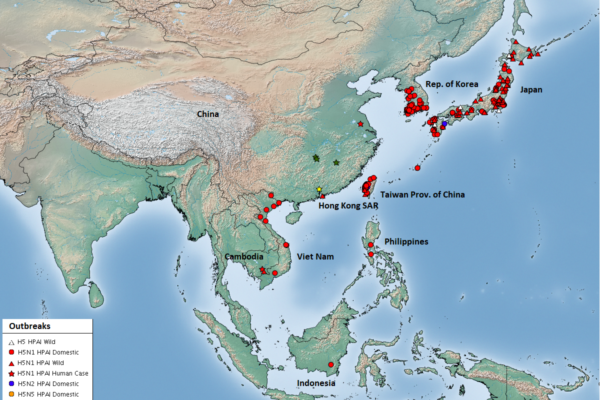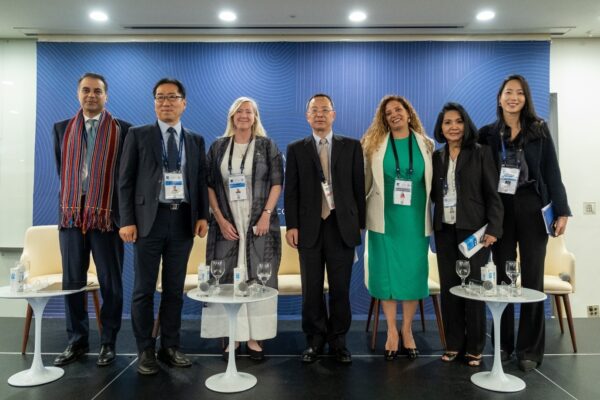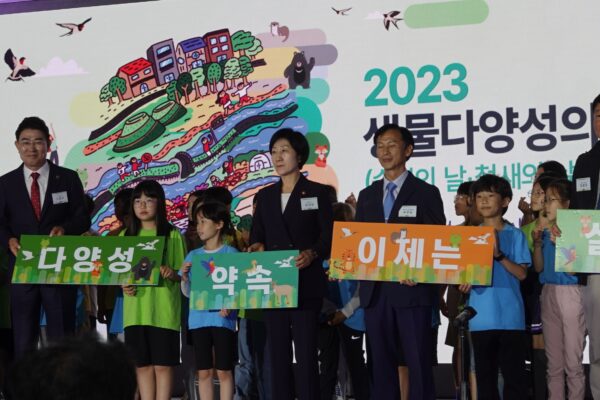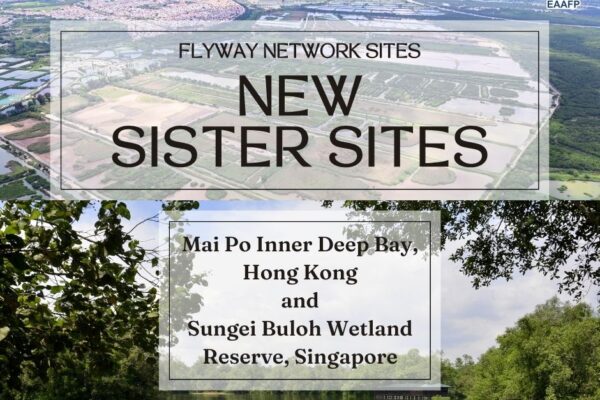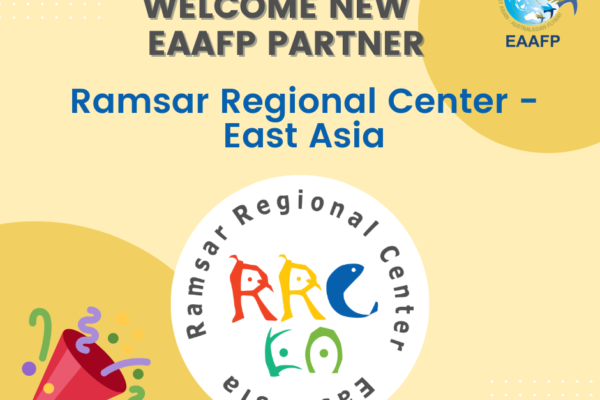-
EAAFP leads happy companionship of humans and nature through the Ulsan Symposium for Migratory Birds
©EAAFP Secretariat On 11th May, the 2023 Ulsan Symposium for Migratory Birds was held to celebrate World Migratory Bird Day at the Ulsan Convention and Exhibition Center (UECO) under the theme of “Migratory birds of Taehwa River and their habitat conservation plan.” The 2023 Ulsan Symposium for Migratory Birds was co-hosted by EAAFP and Ulsan Metropolitan City and sponsored by the four Ulsan companies, Kyungdong City Gas co., Ltd., Korea Petrochemical Ind. Co., LTD., S-Oil Corporation, and Hyundai Motor Company. As part of the Ulsan Corporate Champion Programme, the symposium was achieved through the cooperation for the conservation of migratory birds and their habitats, following the designation of the Ulsan Taehwa River (EAAF150) as an EAAFP Flyway Network Site (FNS) and the signing of an MoU among EAAFP, Ulsan Metropolitan City, and Ulsan corporates in 2021. The symposium consisted of birdwatching and habitat clean-up activities with the four Ulsan Corporate Champions in the morning and a symposium in the afternoon. About 60 employees of Kyungdong City Gas, Korea Petrochemical, S-Oil, and Hyundai Motor Company participated in the EAAFP Ulsan Corporate Champions’ Activity for Conservation of Migratory Birds during the morning of the 11th to observe migratory birds in the Taehwa River and clean up the migratory bird habitats, thereby practicing ESG management. Employees of the four Ulsan corporates toured the Taehwa River area with nature guides to observe migratory birds such as Great Cormorants and Eastern Great Egrets and did habitat cleaning around the area to create a clean environment for the birds living in the Taehwa River. EAAFP Ulsan Corporate Champions’ Activity for Protecting Migratory Birds ©EAAFP Secretariat Employees of four EAAFP Ulsan Corporate Champions engaged in birdwatching and environmental cleanup activities ©EAAFP Secretariat The Ulsan Symposium for Migratory Birds held in the afternoon was attended by various stakeholders, including the four Ulsan corporates that are actively serving as Species Champions in the EAAFP Corporate Champion Programme, the Ulsan Metropolitan City Special Advisor for Environmental Policy, the EAAFP Secretariat, experts, FNS-listed cities, civic groups, research institutes, and corporates, who gathered to seek ways to conserve migratory birds and their habitats. The keynote presentation was given by Mr. Tim McGrath, the Head of Project Development at WWT (Wildfowl & Wetland Trust). Prof. Jong-nam Lee, Kyungsung University, Dr. Won-ho Lee, Nakdong Estuary Eco-Center of Busan Metropolitan City, and Mr. Seong-jin Kim, Upo Ecological Ibis Division of Changnyeong County Tourism and Environment Department, presented during the first session on “Status of migratory birds and Habitat Management in Taehwa River.” The second session on “Happy Companionship Between Nature and Humans” was delivered by Mr. Myeong-ok Kim, SK Energy CLX External Team Leader, Dr. Donguk Han, Director of Eco Korea PGA Ecology Institute and Adjunct Professor at Catholic University, and Ms. Jisun Lee, EAAFP Foundation Coordinator. Prof. Gea-jae Joo of Pusan National University served as the moderator of the third session which had Q&A and discussion. Before the symposium began, Mr. Soo-sik Lee, the Special Advisor for Environmental Policy of Ulsan Metropolitan City gave a commemorative speech. Mentioning the restoration of the heavily polluted Taehwa River through the cooperation of Ulsan citizens, corporates, and various organizations, he said he hoped this symposium would serve as an opportunity to share experiences and knowledge and find a way for migratory birds and people to coexist more happily. Following this, EAAFP Deputy Ms. Yeounhee Ahn gave a congratulatory speech and thanked Ulsan Metropolitan City for their efforts to conserve migratory birds and their habitats in Ulsan, and the four Ulsan corporates who have been actively serving as Species champions in the Ulsan Corporate Champion Programme. She also emphasized that cooperative activities between Ulsan Metropolitan City and participating Ulsan corporates will become a good role model of corporate partnership for conservation and expand domestically and internationally. Mr. Soo-sik Lee, Special Advisor for Environmental Policy of Ulsan Metropolitan City, delivering a commemorative speech ©EAAFP Secretariat Ms. Yeounhee Ahn, EAAFP Deputy, delivering a congratulatory speech ©EAAFP Secretariat The symposium kicked off with a keynote presentation by Mr. Tim McGrath, the Head of Project Development at WWT. Mr. Tim McGrath emphasized that the climate, nature, and welfare crises facing the world can be addressed with nature-based solutions through the creation of blue infrastructure, i.e., wetlands. He highlighted the various benefits of wetlands, such as carbon storage, welfare improvement, flood reduction, and biodiversity restoration, and said that wetland creation and management are necessary. To achieve this, he said, we need to build the capacity of stakeholders to procure and strengthen the necessary public and private partnerships and collaborations. Mr. Tim McGrath, the Head of Project Development at WWT, delivering a keynote presentation ©EAAFP Secretariat After the keynote presentation by Mr. Tim McGrath, the first session, “Status of migratory birds and Habitat Management in Taehwa River” began. In the first presentation, Prof. Jong-nam Lee of Kyungsung University introduced the status of migratory birds in the Taehwa River and Taehwa River’s role as a habitat and stated that standardization and methodology of surveys should be developed to strengthen the bird survey necessary for the conservation of the Taehwa River. He called for long-term training and support at the municipal level to strengthen and nurture the capacity of citizen monitoring groups. Prof. Jong-nam Lee, Kyungsung University, giving a presentation ©EAAFP Secretariat Dr. Won-ho Lee of Busan Metropolitan City Nakdong Estuary Eco-Center informed the participants of the efforts needed to restore the destroyed ecosystem by introducing the process of transforming the Nakdong River Estuary (EAAF097) from a sewage treatment plant and landfill to migratory bird habitat and its current status. The importance of the active role of local government was emphasized in the ongoing ecosystem conservation and maintenance projects, such as the Little Tern habitat restoration project and the conservation measures for swans. Dr. Won-ho Lee, Busan Metropolitan City Nakdong Estuary Eco-Center, giving a presentation ©EAAFP Secretariat Mr. Seong-jin Kim of Upo Ecological Ibis Division at the Changnyeong County Tourism and Environment Department shared the restoration project of the Asian Crested Ibis (EN) habitat in Upo Wetland (EAAF096), which is preparing for successful release into the wild after artificial breeding of extinct Asian Crested Ibises in Ro Korea and emphasized that a community-wide effort is needed for a restoration project. In addition, the successful restoration of Asian Crested Ibises raised the need for considering the impact on the lives of the locals and cooperation with the local community. Mr. Seong-jin Kim, Upo Ecological Ibis Division of the Changnyeong County Tourism and Environment Department, giving a presentation ©EAAFP Secretariat The second session, “Happy Companionship Between Nature and Humans,” began with a presentation by Mr. Myeong-ok Kim, SK Energy CLX External Team Leader. Mr. Myeong-ok Kim emphasized that the happiness of the local community should be given priority through the case of SK Innovation's transition from CSR (Corporate Social Responsibility) to ESG (Environmental, Social, and Governance). He also suggested building a platform to engage all stakeholders to address community issues, emphasizing that the conservation of migratory birds and their habitats is a shared goal for all in the community. Mr. Myeong-ok Kim, SK Energy CLX External Team Leader, giving a presentation ©EAAFP Secretariat In the following presentation by Dr. Donguk Han, Director of Eco Korea PGA Ecology Institute and Adjunct Professor at Catholic University, Dr. Donguk Han cited the Han River Estuary Janghang Wetland (EAAF143), a Ramsar site, as an example of conservation activities involving corporates and civil society and discussed the synergistic effect of trilateral cooperation among non-governmental organizations, corporates, and local governments in the conservation of habitats and biodiversity. Dr. Donguk Han, Director of Eco Korea PGA Ecology Institute, giving a presentation ©EAAFP Secretariat As a final presentation, Ms. Jisun Lee, EAAFP Foundation Coordinator, introduced EAAFP's Corporate Champion Programme, a platform that can internationally certify corporate’s social and environmental contributions, and shared the example of the partnership with the Ulsan Corporate Champions for migratory birds and habitat conservation along with the future plans in the partnership. After the presentation, an appreciation plaque presentation ceremony was held for four Ulsan corporates that contributed to the conservation of migratory waterbirds and their habitats as Species Champions of the EAAFP Corporate Champion Programme. EAAFP Deputy Ms. Yeuon-hee Ahn presented plaques of appreciation to Kyungdong City Gas, Korea Petrochemical, S-Oil, and Hyundai Motor Company, who are actively serving as Species Champions of Black-crowned Night-Heron, Eastern Great Egret, Mandarin Duck, and Long-billed Plover, respectively. Ms. Jisun Lee, EAAFP Foundation Coordinator, giving a presentation ©EAAFP Secretariat Appreciation plaque presentation ceremony for four Ulsan corporates who are serving as Species Champions of the EAAFP Corporate Champion Programme ©EAAFP Secretariat The discussion and Q&A that followed were moderated by Prof. Gea-Jae Joo of Pusan National University. Based on the presentations, the panelists shared their opinions and the discussion proceeded with a Q&A session with the general participants. Prof. Gea-jae opened the discussion by emphasizing that conservation measures and activities of Ulsan Metropolitan City and Ulsan corporates should continue in a virtuous cycle structure through this symposium. In addition, he proposed the creation of a civil society organization specializing in birds in order to build a closer cooperative relationship between Ulsan Metropolitan City and civil society organizations. Ms. Hwa-ja Shin, Natural Environment Team Leader at the Environmental Policy Division of Ulsan Metropolitan City, said that based on the conservation plan discussed at the symposium, Ulsan Metropolitan City would conserve and protect the existing migratory bird habitat together with citizens and corporates. The symposium ended with a closing ceremony and the distribution of Ulsan Corporate Champion Programme goods which were sponsored by the Ulsan Corporate Champions. Panelists participating in the discussion ©EAAFP Secretariat In the 12th, the day after the symposium, Taehwa River birdwatching, Taehwa River National Garden tour, and EAAFP corporate champion S-Oil visit were provided for the symposium participants who wished to attend. The participants were able to reaffirm the history of the Taehwa River and its importance as a habitat in the city that connects migratory birds and Ulsan citizens by visiting the Taehwa River National Garden. Lastly, through a visit to S-Oil Onsan Plant, they were able to take a closer look at the partnership with the local community and ESG management of S-Oil, which is actively serving as the EAAFP Ulsan Corporate Champion. Ulsan Symposium for Migratory Birds participants birdwatching at Taehwa River and touring the Taehwa River National Garden ©EAAFP Secretariat Ulsan Symposium for Migratory Birds participants visiting S-Oil Onsan Plant ©S-Oil Learn more about the EAAFP Corporate Champion Programme Read an article about 2022 EAAFP Ulsan Corporate Champion Programme activity
Continue reading -
Updates of Worldwide Avian Influenza Situation by FAO/EMPRES-AH (Dec 2022 – June 2023)
FAO/EMPRES-AH is constantly monitoring the avian influenza situation worldwide and compiles information from multiple national and international sources as well as peer-reviewed scientific articles. In close collaboration with country and regional offices, the implementation of avian influenza field surveillance projects, and networks of expertise like WOAH/FAO’s OFFLU (www.offlu.org) provide access to timely information on outbreaks, surveillance findings, and genetic similarities of circulating viruses or their virological features. This information is stored in the EMPRES Global Animal Disease Information System (EMPRES-i), a database that can be accessed online at https://empres-i.apps.fao.org/. Avian Influenza in East and Southeast Asia from December 2022 to June 2023 ©EMPRES-I During the period of 3 December to 2 June 2023, six highly pathogenic avian influenza (HPAI) virus subtypes (H5, H5N1, H5N2, H5N5, H5N6, and H5N8) and five low pathogenic avian influenzas (LPAI) virus subtypes (H3N8, H5N2, H7N7, H7N3, and H9N2) have been reported detected in Eastern and South-eastern Asia. H5Nx HPAI viruses continue to circulate in Eastern and South-eastern Asia and reported detections increased since the last report. Within the reporting period, HPAI outbreaks occurred in Cambodia which reported an H5N1 detection in an unspecified wild bird in Prey Veng province caused by the clade 2.3.2.1c. Japan reported HPAI H5, H5N1, and H5N8 affecting numerous species of captive and wild birds including Crane, Crow, Swan, Goshawk, Mallard, Flacon, Eagle, Heron, Buzzard, Owl, Spoonbill, Scaup, Goose, Duck, and Jay as well as outbreaks in poultry caused by H5N1 and H5N2 subtypes leading to the culling of over 14 million birds in 32 provinces. In the Republic of Korea, there were reports of 70 H5N1 outbreaks of clade 2.3.4.4b which affected nearly 4 million domestic poultry in the regions of Chollanam-do, Chungcheongnam-do, Chungchongbuk-do, Gangwon-do, Gyeonggi-do, Gyeongsangbuk-do, Jeollabuk-do, Jeollanam-do, Kyongsangnam-do, Kyonggi-do and Kyongsangbuk-do. Indonesia reported one poultry outbreak caused by the H5N1 clade 2.3.4.4b in Kalimantan Selatan affecting 4430 ducks. Clade 2.3.2.1e viruses have been detected in West Java, Central Java, and Lampung Riau provinces. Viet Nam officially reported nine poultry outbreaks in Cao Bang, Dong Nam, Nghe An, Ninh Binh Quand Ngai, and Quang Ninh provinces affecting 4192 out of 4200 ducks and unspecified birds In China, Taiwan Province reported 66 poultry outbreaks caused by H5Nx, H5N1, H5N2, and H5N5 subtypes that lead to the destruction of over 1 million domestic poultry. Wild birds were affected by the H5, H5N1 subtypes affecting Eurasian teal, Black-faced spoonbill, Gull-billed tern, and Whiskered terns. One H5N1 HPAI detection was reported in Hong Kong SAR, China in Black-faced spoonbill. Outbreaks in poultry caused by low pathogenic subtypes included H9N2 reported in Taiwan, the Province of China, and the H7N7 and H7N3 low pathogenic subtypes were detected in environmental samples. In addition to outbreaks in avian species: A(H5N1) was reported in a fox in Japan in April 2023. In the last update, Viet Nam reported one influenza A(H5) human infection in a 5-year-old female who had exposure to backyard poultry and ducks; the subtype has now been confirmed as A(H5N1). Since the last update A(H3N8) has been reported in Guangdong Provence in China in a 56-year-old female and A(H5N6) in a 49-year-old male. Two clades 2.3.2.1c A(H5N1) cases were reported in Cambodia in an 11-year-old girl (fatal) and her father (mild illness). In Anhui province, one clade 2.3.4.4b A(H5N1) human infection was reported in a 53-year-old female. 5 human cases of A(H9N2) were reported in children in the Hunan (3), Jiangxi (1) and Sichuan (1) provinces. Most of these cases reported exposure to backyard poultry and any human-to-human transmission has been ruled out. Since 2014 (as of 3 June 2023), there have been 83 human cases of influenza A(H5N6) have been reported, 82 occurring in China and one in Lao People's Democratic Republic with the most recent case reported on 2 February 2023 with an onset of disease on 17 December 2022 in China. Both the clade 2.3.2.1c and the clade 2.3.4.4b A(H5N1) have caused disease in humans since 2020. The most recent reports of each had an onset of 23 February 2023 and 31 January 2023 respectively. To date 116 influenza A(H9N2) human cases have been reported worldwide with at least 96 cases reported in China since December 2015. The most recent case was reported on 9 March 2023 with an onset date of 5 February 2023 in China. Highly pathogenic Goose/Guangdong lineage clade 2.3.4.4b H5Nx viruses have demonstrated the ability to spread long distances via migratory water birds. These viruses are continuing to infect an increasing range of wild bird species. This has led to an increase in infections reported in mammalian species which often display neurological symptoms. Globally the impacts on ecologically important birds, such as seabirds have been increasingly noted and are implicated in spread. Asia has experienced repeated incursions of the virus from multiple directions as well as circulation. We expect avian influenza activity to maintain in Asia. Reports of outbreaks in poultry, detections in wild birds and occasional detections in mammalian species are expected to continue in the region over the coming months. Please click [here] to view a larger version of the table above
Continue reading -
Report on meeting of the Range States of the Central Asian Flyway
Dr. Taej Mundkur introducing EAAFP at the meeting © Hanns Seidel Foundation, Korea Between 2nd and 4th May, 2023, a Central Asian Flyway (CAF) Range States meeting was organised by the Convention on the Conservation of Migratory Species of Wild Animals (CMS) Secretariat and hosted by the Government of India with support of the Wildlife Institute of India, in New Delhi, India. The meeting was attended by 75 representatives of government and relevant organizations, aiming to discuss an institutional framework for the conservation of migratory birds and their habitats in the CAF. Dr. Taej Mundkur, attended on behalf of BirdLife International to present the CAF Situation Analysis report on migratory birds and their habitats. He also on behalf of the East Asian – Australasian Flyway Partnership (EAAFP), as Vice Chair of the Technical Sub-Committee, gave a presentation to share the case in EAAFP, of which BirdLife International and the CMS Secretariat are partners. The CAF covers 30 countries, including the breeding grounds of many birds in central and eastern Russia, Central Asia, west, central and northern China, and Mongolia. The CAF lies between the East Asian – Australasian Flyway and African Eurasian flyways. It overlaps with both, particularly in the northern and central latitudes where many of the birds breed and stage during migration. This meeting built on the history of previous meetings of the CAF range states (in Uzbekistan, 2001, India 2005, United Arab Emirates 2012, and India 2019) and follows on the decisions of the 13th meeting of the Conference of the Parties (COP13) to CMS, held in Gandhinagar, India, in 2020, to establish an institutional framework to support the implementation of conservation action for migratory birds and their habitats in the region, by CMS COP14 due in October 2023. The three-day meeting was attended by 75 representatives of governments from the following 12 countries: Armenia, Bangladesh, Kazakhstan, Kuwait, Kyrgyzstan, Mongolia, Oman, Saudi Arabia, Tajikistan, Uzbekistan, and India together with representatives of the Secretariats of CMS, the Memorandum of Understanding on the Conservation of Migratory Birds of Prey in Africa and Eurasia (Raptors MOU), the African-Eurasian Migratory Landbirds Action Plan (AEMLAP) and the East Asian – Australasian Flyway Partnership (EAAFP) and of international organisations including BirdLife International, Hanns Seidel Foundation, IUCN, WWF – India and Wetlands International - South Asia, national NGOs including Bombay Natural History Society, senior representatives of the forest department of different states of India, national organisations and others. The meeting discussed ways to promote international cooperation between range states to conserve and reverse the decline of nearly 600 species of migratory birds of over 80 families, including waterbirds (e.g. cranes, ducks, geese swans, pelican, shorebirds, gulls, terns), birds of prey (e.g. eagles, vultures, falcons), bustards and other land birds and seabirds that migrate and depend on a variety of habitats within the CAF. There was broad recognition of work in these countries on a number of species and habitats including research, monitoring, conservation, and restoration, capacity building, and awareness-raising, involving citizen science, researchers, conservationists, NGOs, local grass-roots organisations, and the corporate sector, in addition to by national and local government agencies and inter-government frameworks. Dr. Taej Mundkur presenting about the EAAFP at the meeting ©Mohamed Shobrak The main outcomes of the meeting were to: Discuss and agree on an institutional framework for the CAF for all migratory birds through the establishment of a CAF Initiative, under the umbrella of the CMS and with the support of the Government of India, that will include governments, MEAs, international organisations, international NGOs and other stakeholders. Consider options for a CMS CAF coordination unit to be hosted by India in coordination with the CMS Secretariat. Draw conclusions from a draft comprehensive CAF Situation Analysis report presented by BirdLife International and discuss priority areas for implementation. The report highlights the degradation and loss of all habitats and direct threats to birds including increasing collision and electrocution from power lines and other energy and linear infrastructure, and illegal killing, and poisoning across the flyway. The meeting agreed to contribute to the finalization of the report by providing feedback by the end of May to meet the aim of making the final report available at the CMS COP14 in Uzbekistan in October 2023. Develop and agree on a draft roadmap for updating the CMS CAF Programme of Work and Action Plan. Develop and agree on a draft CMS Resolution text, and the Terms of Reference for the new Initiative, as well as CMS Decisions outlining the next steps in the development of the initiative. These documents would be proposed for consideration and adoption to the CMS COP14 in Samarkand, Uzbekistan (Oct 2023). The new CAF Initiative will recognize, support, and strengthen regional and national implementation of existing international frameworks (incl. AEWA, Raptors MOU, AEMLAP, CAF Waterbird Action Plan, and EAAFP ) in the CAF region. The initiative will also undertake a range of actions, funding permitted, as per a Programme of Work and Action Plan to be developed in the future to conserve migratory birds and their habitats. The meeting called for the first meeting of the CAF initiative to be organised in 2024 to progress the establishment of the coordination mechanism and confirm modalities for operations of the initiative and priority collaborative actions. Outcome documents of the meeting and all presentations are now available at the CAF Meeting website: https://www.cms.int/en/meeting/meeting-range-states-central-asian-flyway Prepared by Taej Mundkur, Good Earth Environmental
Continue reading -
EAAFP engagement at the ADB 56th Annual Meeting of the Board of Governors
Panel Discussion at the side event “The Steps for Making the Regional Flyway Initiative a Reality” ⓒ EAAFP Secretariat The 56th Annual Meeting of the Board of Governors of Asian Development Bank (ADB), hosted by the Ministry of Economy and Finance of the Republic of Korea, was held in Songdo, Incheon, Republic of Korea, from 2nd to 5th May 2023. The theme of the 56th ADB Annual Meeting is “Rebounding Asia: Recover, Reconnect, and Reform”. About 5,000 people, including finance ministers and central bank governors from ADB members, and representatives from the government and private sectors, local and international organizations, and the press participated in meetings, seminars, and side events to discuss various topics regarding development in Asia. A side event on the Regional Flyway Initiative, co-organized by ADB, BirdLife International and EAAFP was held on 2nd May. Regional Flyway Initiative Side event During the side event entitled “The Steps for Making the Regional Flyway Initiative a Reality” (link) held on 2nd May, panelists discussed the ongoing process since the launch of the RFI and to underline actions needed to facilitate its progress from the development phase into the implementation phase. ⓒ Asian Development Bank The event was moderated by Ms. Patricia Zurita, Chief Executive Officer of BirdLife International. Ambassador Chantale Yok-Min Wong, (United States Ambassador toADB) gave an opening remark emphasizing the need for the long-term commitment and cooperation between ADB and the US. Following was the panel discussion. Our Senior Programme Officer, Ms. Hyeseon Do, participated as a panelist, together with Mr. Weihua Liu (People’s Republic of China Executive Director, ADB), Ahmed Saeed (Vice-President for East Asia, Southeast Asia, and the Pacific, ADB) Ms. Elisea G. Gozun (Chair of Compliance Review Panel, ADB) to discuss how to make the RFI feasible. They all highlighted that the national/international cooperation among people including ADB Board members and organizations, as well as wetlands conservation, is crucial to successfully implement the RFI. After the discussion, Mr. Jae Young Shin, Director of the Maritime Policy Office, Maritime Ecology Division of the Ministry of Oceans and Fisheries, Republic of Korea, gave a message of future support by highlighting future conservation cooperation between the ADB and Ministry of Oceans and Fisheries and Ms. Dawn Bennet, Ambassador to Republic of Korea, New Zealand Government, delivered a closing remarks to encourage transboundary conservation efforts. Engaging at ADB 56th Annual Meeting events The EAAFP staff participated in several side events and seminars, such as a program called “Civic Engagement and Multi-Stakeholder Partnership for SDGs in Asia”, a side event called “Digital, Climate, and Resilience”, “The Green Transition, Needs a Green Workforce: The Role of Skills Development for a Just Transition”, etc. From the side events, a key lesson learned was that the engagement of multi stakeholders including civil society and youths is crucial to the implementation of projects related to SDGs. In line with the EAAFP’s mission, cooperation among various sectors is highly significant to conservation activities. One of the key agendas discussed during side events was the role of climate finance in the funding of projects and initiatives related to climate change mitigation. They provided information regarding future investments as well as how organizations may access these funds. This knowledge may prove valuable if the EAAFP or its Partners were to seek funding for projects in the future. A booth of the Regional Flyway Initiative (RFI) and the Jiangsu Yancheng Wetlands Protection Project prepared by the ADB-PRC Regional Knowledge Sharing Initiative (RKSI) was presented. The booth also had a virtual reality (VR) activity where with the VR headset people can look around several Flyway Network Sites and tablets where people could scan each picture on the booth wall regarding the investment in the RFI, RFI areas, and Asia and the Pacific’s climate risk, and receive information relevant to the picture. The tablets also showed a map of migratory birds’ flyways and the information about each site so people visiting the booth could learn about the importance of conservation of migratory birds and their habitats. The EAAFP staff also visited several other booths form the Incheon City, various corporates and organizations where people could do various activities, participated in the activities to introduce the EAAFP and RFI, and learn about the other institutions’ work. Booth at the meeting ⓒ EAAFP Secretariat EAAFP Secretariat also contributed to a 1-minute interview video with ADB to promote the RFI (Twitter, Instagram). Ms. Hyeseon Do mentioned that we should take immediate action to conserve migratory waterbirds and their habitats, to fight against ecosystem degradation by humans and mitigate climate change. Also, together with ADB and Birdlife International, EAAFP will try to develop the RFI and scale up nature-based solutions to combat environmental challenges by conserving the wetlands in the East Asian-Australasian Flyway. ⓒ EAAFP Secretariat Guided by staff from the Secretariat before the meeting, the RFI organizers team from BirdLife International and ADB visited several migratory birds’ habitats in Incheon, such as Songdo Flyway Network Site and Ramsar Site, Ganghwa Island, and Namdong Reservoir (breeding site for Black-faced Spoonbill) and Sorae Wetland Park. Ms. Patricia Zurita (CEO), Mr. Vinayagan Dharmarajah (Regional Director for Asia), Mr. Gary Allport (Senior Adviser to the CEO) from BirdLife International, and Mr. Duncan Lang (Senior Environment Specialist) from ADB visited the EAAFP Secretariat after the RFI side event on the 2nd May. Group photo with Ms. Patricia Zurita, Mr. Vinayagan Dharmarajah, Mr. Gary Allport from BirdLife International, and Mr. Duncan Lang from ADB visited EAAFP Secretariat © EAAFP Secretariat Left to right: Mr. Duncan Lang and Mr. Warren Evans from Mr. Gary Allport © EAAFP Secretariat About Regional Flyway Initiative Launched in October 2021 at the 15th Conference of Parties to the Convention on Biological Diversity (CBD COP15), Regional Flyway Initiative (RFI) is a large-scale long-term financing initiative by the ADB, EAAFP, and BirdLife International to support the conservation, restoration, and efficient management of wetlands in the EAA Flyway. A partnership of multiple stakeholders will collaborate to develop the RFI program, scaling up the Flyway-wide conservation efforts to protect wetlands and the migratory waterbirds and the lives of the people who are dependent on them. The initiative aim to build and protect an ecological network of at least 50 priority sites over the next 10 years. For more information on RFI, click here.
Continue reading -
Happy Birthday Black-faced Spoonbill: A Celebration of Conservation with local community
Group photo of BFS Birthday Party Participants ©️ EAAFP Secretariat The Black-faced Spoonbill Birthday Party held on 20th May at the Black-faced Spoonbill (BFS) Eco Center at Namdong Reservoir, Incheon, Ro Korea, was a vibrant and joyful event that brought together families, artists, musicians, and civil society groups dedicated to protecting this endangered species. This event was hosted by Incheon Metropolitan City and Incheon Metropolitan City Office of Education, and BFS Eco Center, BFS NGO Network. The primary aim of the party was to raise awareness of the community and foster a sense of ownership towards the Black-faced Spoonbill (BFS) population breeding on the reservoir's artificial islands, particularly celebrating the birth of new chicks. Black-faced Spoonbill drawing by children ©️ EAAFP Secretariat The event successfully combined art, music, and interactive activities to promote BFS conservation. Families and children filled the venue, engaging in various BFS-themed booths and workshops. Some young artists created stunning drawings of the Black-faced Spoonbill, while others made BFS prints using paint and wood blocks. Sustainability was at the core of the event, with all materials being recycled or encouraged to be biodegradable. EAAFP Booth at BFS Birthday Party ©️ EAAFP Secretariat EAAFP Secretariat explained how to play Lolo’s Flying Journey game to children ©️ EAAFP Secretariat Children wrote the answer for questions at the BFS checkpoint ©️ EAAFP Secretariat The East Asian-Australasian Flyway Partnership (EAAFP) played its part in the celebration by organizing an engaging booth. The main activity was a modified version of the game "Lolo's Flying Journey," where children “experienced” BFS migration route with 5 checkpoints. At each checkpoint, they answered questions about the BFS, including its characteristics, environment, behavior, and the challenges they face. Upon completing the journey, participants received prizes of their choice at the EAAFP booth. The staff at the booth also disseminated brochures, stickers, and posters, offering an educational platform for visitors to learn about the BFS as well as other migratory birds. The BFS flower birthday cake made by children ©️ BFS & Friends Having games at the BFS Birthday Party ©️ BFS & Friends To foster a deeper connection with the species, attendees made flower cakes using clay and fresh flowers as presents for the BFS. They also wore hats featuring tidal flat species, made necklaces and key rings from marine trash, and enjoyed taking polaroid pictures with the Black-faced Spoonbill mascot at the photo booth. Additionally, scopes were set up to provide the public with an opportunity to observe the BFS and their new chicks up close. Ms. Ahn Yeounhee, Deputy Chief Executive of EAAFP giving remarks at the closing ceremony of BFS Birthday Party ©️ EAAFP Secretariat As the joyful day came to an end, participants gathered to sing songs about the Black-faced Spoonbill, including a heartfelt rendition of Happy Birthday. The event succeeded not only in celebrating the milestone of another successful year of the BFS breeding at Spoonbill Island, Namdong Reservoir but also in promoting a sense of community ownership and the importance of collective actions to protect this endangered species. Through art, music, and interactive activities, the Black-faced Spoonbill Birthday Party left a lasting impact, inspiring attendees to continue their efforts in conserving this magnificent bird and its habitat as a vital part of Korean natural heritage. (Korean Version) 저어새야 생일 축하해: 지역사회와 함께하는 보전 활동 저어새 생일잔치 단체사진 ©️EAAFP사무국 5월 20일 인천 남동유수지의 저어새 생태학습관에서 열린 저어새 생일잔치는 가족, 예술가, 음악가, 시민사회단체들이 멸종위기종 보호에 헌신한 활기차고 즐거운 행사였다. 이 행사는 인천광역시와 인천광역시교육청, 그리고 저어새 NGO 네트워크인 저어새 생태학습관이 주최했다. 이 행사의 주요 목적은 지역 사회의 저어새 보전에 대한 인식을 높이고 남동유수지의 인공 섬에서 번식하는 저어새 개체에 대한 의식, 특히 새끼 저어새의 탄생을 축하하는 것이었다. 저어새 생일잔치 홍보 포스터 ©️저어새 생태학습관 행사에 참여한 어린이들의 저어새 그림 ©️EAAFP사무국 이 행사는 저어새 보전을 촉진하기 위해 예술, 음악, 그리고 인터랙티브한 활동들을 성공적으로 결합시켰다. 참가 가족들과 어린이들이 다양한 저어새 테마 부스와 워크숍에 참여하며 행사장을 가득 채웠다. 어린이들은 저어새 그림을 그리기도 하고, 페인트와 나무 블록을 사용하여 저어새를 만들기도 하였다. 모든 재료가 재활용되거나 생분해가 가능하는 등 지속 가능성이 핵심이 되는 행사였다. 저어새 생일잔치에 설치된 EAAFP 부스 ©️EAAFP사무국 EAAFP 부스에서 진행한 저어새 롤로의 하늘을 나는 여행 게임에 참여하고 있는 참가자들의 모습 ©️EAAFP사무국 동아시아-대양주 철새이동경로 파트너십(EAAFP)은 참여 부스를 마련하여 인식증진 활동에 박차를 가했다. 주요 활동은 게임 "저어새 롤로의 하늘을 나는 여행"의 수정된 버전으로, 어린이들이 5개 체크포인트의 저어새 이동 경로를 체험했다. 어린이들은 각 체크포인트에서, 저어새의 특징, 환경, 행동, 그리고 저어새가 직면한 위험요소를 포함한 질문에 답했다. 여행을 마친 후, 참가자들은 EAAFP 부스에서 상품을 받았다. EAAFP사무국의 직원들은 브로셔, 스티커, 포스터를 상품과 함께 배포하여 방문객들이 저어새와 다른 철새들에 대해 배울 수 있는 교육 플랫폼을 제공했다. 어린이들이 꽃으로 제작한 저어새 생일 축하 케이크 ©️EAAFP사무국 저어새 관련 게임을 진행하는 모습 ©️저어새와 친구들 참가자들은 진흙과 꽃을 사용하여 저어새 생일을 축하하기 위한 꽃 케이크를 만들었다. 또한 이번 행사에서는 갯벌에 사는 생물종들을 형상화한 모자를 쓰고, 해양 쓰레기로 목걸이와 열쇠 고리를 만들었고, 사진 부스에서 저어새 마스코트와 함께 폴라로이드 사진을 찍는 등 다양한 체험활동이 진행되었다. 그 밖에도 스코프를 설치하여 저어새와 새로 태어난 새끼들을 가까이서 관찰할 수 있는 기회를 제공하였다. 행사 폐회식에서의 안연희 EAAFP 사무국장의 모습 ©️저어새와 친구들 참가자들은 생일 축하 노래를 포함하여 저어새에 대한 노래를 불렀다. 이번 행사는 남동 저수지의 저어새 섬에서 저어새 번식의 성공적인 한 해를 기념하는 것뿐만 아니라, 공동체 의식과 멸종위기종을 보호하기 위한 집단 행동의 중요성을 홍보하는 데 성공했다. 예술, 음악, 그리고 인터랙티브한 활동들을 통해, 저어새 생일잔치는 지속적인 영향을 남겼고, 참가자들이 대한민국 자연 유산의 필수적인 부분으로서 저어새와 서식지를 보전하기 위한 노력을 지속할 수 있는 영감을 주었다.
Continue reading -
Korean Government celebrated the 2023 International Day for Biological Diversity, calling for actions to build back biodiversity
highlighting the theme “From Agreement to Action: Build Back Biodiversity.” ©Ejin Kim/EAAFP On the day of International Day for Biological Diversity, 22nd May, the Ministry of Environment Korea and the Ministry of Oceans and Fisheries hosted an event to celebrate 2023 World Wetlands Day, World Migratory Bird Day, and International Day for Biological Diversity with Suncheon City and Korean Environmental Preservation Association (KEPA). The event was held in Suncheon Bay National Garden, Suncheon, Ro Korea, with the theme, ‘From Agreement to Action: Build Back Biodiversity’. During the ceremony, the Presidential Prize, Prime Minister Prize, and the Minister of Environment Prize were given to recognize the contribution of individuals to the environment. Flyway Network Site Suncheon Bay is one of the key sites for migratory waterbirds, especially acknowledging the wintering ground for Hooded Cranes. Suncheon Bay is also a Ramsar Site and in 2021 was designated as one of the UNESCO World Heritage Sites. After the opening performance, the ceremony kickstarted with opening and congratulatory speeches by Ms. Han Hwa-jin, the Minister of Environment; Mr. Roh Gwan-gyu, Suncheon Mayor, Mr. Song Myeong-dal, Director of Ocean Policy at the Ministry of Oceans and Fisheries, Mr. Park Chang-hwan, Jeollanam-do Deputy Governor for Political Affairs, Mr. Kim Jong-ryul, Deputy of Environment Conservation at the Ministry of Environment, and more. In their speeches, they all emphasized environmental issues, climate change, and the importance of nature conservation. Ms. Han Hwa-jin, the Minister of Environment delivering the opening speech ©️ EAAFP Secretariat Song Myeong-dal, Director of Ocean Policy at the Ministry of Oceans and Fisheries delivering opening speech ©️ EAAFP Secretariat Then, the ceremony went on with the presentation of 3 categories of prizes by the Minister of Environment to awardees with contributions to the environment. Ms. Vivian Fu, Senior Communication Officer at EAAFP Secretariat, was awarded the Minister of Environment Prize for contributing to World Migratory Bird Day, for her effort in awareness raising for migratory waterbird conservation and promotion of the World Migratory Bird Day in the region. Group photo of Minister of Environment Prize awardees ©️ EAAFP Secretariat Vivian Fu, Senior Communication Officer, was awarded the Minister of Environment Prize ©️ EAAFP Secretariat The event closed with a local student choir from elementary schools performing two songs with dances. In the mid of the performance, they invited the ministers, the Mayor, and the representatives on stage to hold the slogan of the event “From Agreement to Action: Build Back Biodiversity” to remind the importance of taking action for biodiversity. Students and honorable guests promoting the theme of the event “From Agreement to Action: Build Back Biodiversity” at the closing stage ©️ EAAFP Secretariat
Continue reading -
Farewell to Eugene Kim, Communication Assistant
In the words of Eugene Kim, “As a Global Affairs major, I always desired to work in an international organization where I can learn how people work together to protect the wetlands and the migratory birds, in the concept of SDGs. When I took Environment 201 and 337 classes, I found out that we, humans are the only existences who can help the environment to recover. All existences including humans, living things, and non-living things are interconnected to each other. Therefore, I thought the term ‘Sustainable Development’ is the most important goal for us. Since EAAFP is an international organization that works for migratory birds and sustainable management, I want to be involved in the process where EAAFP plays a positive role in the world. As a Communication Assistant, my main tasks were dealing with the main homepage by creating new pages and uploading the materials including MOP 11 resources and articles. I also kept track of the media archive on how EAAFP and migratory birds are reported in the media around the world. Furthermore, I communicated with external organizations and companies to organize an event or order posters and banners we need for new events we are holding. As a Global Affairs major, I always desired to work in an international organization where I can learn how people work together to protect the wetlands and the migratory birds, in the concept of SDGs. For my whole life, I dreamed to be a person who can work for the coexistence of people and the environment. To achieve this goal, I wanted to give hands to people who are not protected with their human rights for sexual, economic, and social reasons. After handling the issue of humans, I wanted to save the environment, including living things and non-living things that are getting extinct. What I have learned through the EAAFP internship was the importance of challenging new tasks, without any hesitation. Since I have been studying as a Global Affairs student, I have never done computing work before. Therefore, it was my first-time creating webpages, uploading materials using coding, and managing our EAAFP website by myself. At first, I was so afraid that I make a mistake, and I doubted if I can do this by myself. However, surprisingly, I am dealing with website management very well right now and became an expert in this area. The biggest events I handled were the 3rd Incheon-Hong Kong International East Asian-Australasian Black-faced Spoonbill Conservation Cooperation Forum, MOP 11, and World Migratory Bird Day Small Grant Fund 2023. 3rd Incheon-Hong Kong International East Asian-Australasian Black-faced Spoonbill Conservation Cooperation Forum © EAAFP Secretariat The first event I participated in was the 3rd Incheon-Hong Kong International East Asian-Australasian Black-faced Spoonbill Conservation Cooperation Forum, which was the first business trip in my life. During the forum, I had to take pictures of participants with cameras, oversee audio during meetings, monitor computers, and interpret participants’ communication. It was a difficult but meaningful time to share ideas about spoonbills protection and wetland conservation with the Ministry of Environment of Incheon, the Incheon Metropolitan Office of Education, the Incheon Green Union, the WWF, the Hong Kong Special Administrative Region Agricultural and Fishery Conservation Department, and various government officials. I learned how many people are putting their effort to protect the wetlands and the migratory birds, which are correlated to our lives as well. Red-crowned Crane © Eugene Kim Secondly, in preparation for MOP 11, I had to deal with creating web pages, and uploading all the materials as requested by the EAAFP secretariat. Since the way I create the webpage directly impacts people’s views on MOP 11 and EAAFP Secretariat, I felt a big pressure and responsibility. Thanks to all effort, MOP 11 ended successfully, resulting in great decisions as well. Thirdly, I handled the World Migratory Bird Day Small Grant Fund for 2023. It was my first time dealing with official contracts, being in the middle of the Secretariat and applicants. The way EAAFP Secretariat gives financial opportunities to the applicants to teach students how much it is important to save migratory birds and wetlands was very impressive. Visit to Ganghwa Spoonbill Cafe © EAAFP Secretariat During my internship period, I am so glad that I learned a lot and experience in various fields. I was able to learn about myself as well, testing my abilities and courage in learning new tasks. It was an honor for me to work with great interns as fellows and staff, who are very professional in the working area with their own experts. It also enabled me to enhance my English skill as well. I will never forget this precious moment working with EAAFP Secretariat I had in my life, and my life journey will continue to move on to the next step of my career.”
Continue reading -
Mai Po Inner Deep Bay in Hong Kong and Sungei Buloh Wetland Reserve in Singapore announced Sister Sites
Photo shows the Mai Po Inner Deep Bay Ramsar Site in Hong Kong (left) and Sungei Buloh Wetland Reserve in Singapore (right) In line with World Migratory Bird Day, the Agriculture, Fisheries and Conservation Department (AFCD) of Hong Kong S.A.R., the National Parks Board of Singapore, the World Wide Fund for Nature Hong Kong and the World Wide Fund for Nature Singapore signed the Memorandum of Understanding (MoU) for the conservation of migratory waterbirds on 12 May, 2023. This MoU establishes the Sister Sites between the Mai Po Inner Deep Bay Ramsar Site (Flyway Network Site EAAF 003) in Hong Kong S.A.R. and the Sungei Buloh Wetland Reserve (Flyway Network Site EAAF 073) in Singapore following the Sister Site Programme of East Asian-Australasian Flyway Partnership. This is the first Sister Site Agreement of EAAFP since the adoption of Guidelines for the EAAFP Sister Site Program during the 11th Meeting of Partners (MOP11). The Sister Site Agreement showcased collaboration among government agencies and NGOs. Areas of cooperation include mutual assistance in the continuous development and management of the Mai Po Inner Deep Bay Ramsar Site and the Sungei Buloh Wetland Reserve. In addition, the MoU signing parties involved will initiate collaboration in research on migratory shorebirds, exchange of expertise and training on the management of wetland habitats, and promotion of the sites. Dr Leung Siu-fai, Director of Agriculture, Fisheries and Conservation said, “Tomorrow is World Migratory Bird Day which aims to raise awareness on the conservation of migratory birds and the wetland habitats they depend on. The conservation of migratory birds especially requires collaboration across the region. The MoU demonstrates that Hong Kong and Singapore are committed to the conservation of wetlands and migratory waterbirds through closer collaboration.” Ms Nicole Wong, CEO of WWF-Hong Kong said, “WWF-Hong Kong has been managing Mai Po Nature Reserve in collaboration with AFCD since 1983. The MoU with Sungei Buloh Wetland Reserve lays the foundations for a future partnership that will improve the management of both wetlands, allow for the exchange of expertise and knowledge, and secure an integrated network of wetland ecosystems for migratory shorebirds.” Dr. Leong Chee Chiew, Commissioner of Parks & Recreation and Executive Director, National Parks, Gardens and Nature Reserves of the National Parks Board of Singapore said, “International cooperation is key to supporting migratory shorebirds as they require multiple refuelling stops on their long-distance travels to roost and feed. Sungei Buloh Wetland Reserve and Mai Po Inner Deep Bay serve as two important sites along the East Asian-Australasian Flyway. This MoU will strengthen the partnership between the two wetlands, and the National Parks Board will continue building cross-border collaboration on the conservation of wetland sites to protect these shorebirds and their habitats.” "WWF-Singapore recognises the significance of both these wetlands for migratory birds. This transnational collaboration between NParks, AFCD, WWF-Hong Kong and WWF-Singapore will enable more opportunities for protection and conservation work. We also look forward to amplifying the conservation efforts of habitats and species in these wetlands through our upcoming contribution to educational programmes in Singapore," said Mr. R. Raghunathan, CEO of WWF-Singapore. Learn more about: Mai Po Inner Deep Bay Ramsar Site (Flyway Network Site EAAF 003) in Hong Kong S.A.R. (here) Sungei Buloh Wetland Reserve, Singapore (Flyway Network Site EAAF 073) (here) EAAFP Sister Site Program (here) Read the original news release: https://www.info.gov.hk/gia/general/202305/12/P2023051200276.htm https://www.wwf.org.hk/en/?25563/Mai-Po-and-Sungei-Buloh-establish-Sister-Wetlands
Continue reading -
EAAFP welcomes Ms. Jennifer George as New Chief Executive
The East Asian-Australasian Flyway Partnership (EAAFP) is delighted to announce the appointment of Ms. Jennifer George from New Zealand, as its new Chief Executive of the Secretariat, effective on 20th June 2023. With a distinguished career in various sectors, and being a lawyer in practice, Ms. George brings a wealth of experience and a passion for driving positive change to her role in leading the EAAFP’s mission of conserving migratory waterbirds and their habitats along the East Asian-Australasian Flyway. Her recent remarkable contributions extend to her role as an EAAFP consultant for developing the recently adopted MOP11 Decision Papers namely “Guidelines for EAAFP National and Site Partnerships” and “’ Guidelines for the EAAFP Sister Site Program”. Many of you might have discussed with her during the consultation period of the Guidelines and met her at MOP11 this March, in Brisbane, Australia. Her expertise and collaboration with the EAAFP Secretariat and Partners have resulted in driving momentum to the development of the partnership. She is also an active member of the EAAFP Partner, Pukorokoro Miranda Naturalists Trust, where her interest and passion for conserving migratory waterbirds has built up. Ms. George has an extensive background as a performance-driven professional that spans government, law, education, business development, and the non-profit sector. She worked in the Secretariat of the Climate Change Chief Executives Board of the Ministry for the Environment, New Zealand, to provide advice on best practice governance, and lessons learned from similar arrangements, mentor analysts, and improve governance systems and processes. She has years of experience in governance and served in the governmental sector for the New Zealand Qualifications Authority, Ministry of Justice, Wellington City Council, New Zealand. Her roles ranged from analyst and project manager to convenor of an expert panel. As a governance consultant, Jennifer has been instrumental in developing best-practice governance frameworks for Crown Entity and local governments, ensuring compliance with legislative requirements, and fostering efficient processes. Her research and advocacy have resulted in policy changes at the governmental level. She also has 10 years of teaching experience in a secondary school and had been served as Head of Department, as well as a board member to Central Regional Health School, where she proved her skills in education and management. In addition, her role as Development Director of Henwood Trust with Māori (New Zealand’s indigenous people) communities demonstrated her leadership in developing and cultivating strategic relationships with indigenous people and diverse stakeholders to bring positive changes. Her track record of success in facilitating transformational outcomes for organizations and communities showcases her exceptional leadership skills and her ability to collaborate effectively with diverse stakeholders, including government officials, academics, professionals, Indigenous communities, philanthropy, and NGOs. These diverse cross-sector skill sets would equip her well to lead EAAFP to implement the Strategic Plan and CEPA Action Plan for the next years. We are thrilled as Ms. Jennifer George takes the helm as the Chief Executive of the EAAFP Secretariat. Please join us to welcome her to the Secretariat.
Continue reading -
Welcome Ramsar Regional Center – East Asia (RRC-EA) as EAAFP’s 40th Partner!
Today, the East Asian-Australasian Flyway Partnership (EAAFP) is delighted to announce the Ramsar Regional Center – East Asia (RRC-EA) as its 40th Partner. This new partnership would enhance collaborative effort, especially on CEPA (Communication/Capacity Building, Education, Participation and Awareness) on wetlands and migratory waterbird conservation in the Asian region of the East Asian – Australasian Flyway. RRC-EA is one of the Ramsar Regional Initiatives adopted by the Ramsar Convention. Based in Suncheon City of the Republic of Korea, it was established through the initiative of the Ministry of Environment (MOE) of the Republic of Korea to serve as a regional platform for capacity building, information exchange, and cooperation among governments, Ramsar Sites and wetland managers and stakeholders, international and national non-government organizations, technical experts and business organizations. One of the primary areas of focus for the RRC-EA is to build capacity and provide technical assistance to countries in the region to build capacity in wetland management, and to develop CEPA programmes. It leads the development of a regional CEPA strategy to raise awareness and promote the value of wetlands and their conservation in the region, including the development of Wetlands Link International (WLI) - Asia-Oceania, a network of wetland centres that promotes the sharing of knowledge, experience, and best practices in wetland conservation and management. With their focus aligning with the EAAFP's mission, RRC-EA has been actively collaborating with the EAAFP for many years, and their partnership was officially strengthened in December 2020 when they signed a Memorandum of Understanding (MoU) (link). The MoU aims to strengthen cooperation in common activities in the field of wetland conservation, especially on the expansion of cooperation and co-organization of capacity building, training and awareness-raising to relevant stakeholders at regional and national levels. Celebrating the new partnership, Mr. Suh Seung Oh, Executive Director of the Ramsar Regional Center - East Asia stated, "We are honored to become the 40th partner of the East Asian-Australasian Flyway Partnership. Wetlands are crucial habitats for migratory waterbirds, and our collaboration will enable us to work together more effectively to conserve these ecosystems and the waterbirds that depend on them. We look forward to sharing our expertise in wetland conservation, to promote and raise awareness of the importance of wetland conservation." The RRC-EA's expertise in wetland conservation and CEPA programs will be a valuable asset to the partnership's efforts to conserve migratory waterbirds and their habitats along the East Asian-Australasian Flyway. Visit RRC-EA's homepage: http://rrcea.org/
Continue reading
